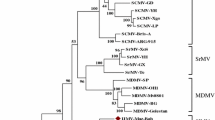Summary.
The coat protein gene of the papaya ringspot virus was cloned and sequenced in three Mexican isolates (two from Veracruz, and one from Chiapas). The sequences of these viral isolates were compared to those of eleven isolates from other parts of the world. They had higher similarity to isolates from Australia and the United States than to Asian isolates. A region of about one hundred nucleotides neighboring the putative aphid transmission triplet of the coat protein, contained repeats of an EK (glutamic acid-lysine) motif in all the sequences. The bearing of this region on the genetic relationships and geographical distribution of the isolates is analyzed and discussed.
Similar content being viewed by others
Author information
Authors and Affiliations
Additional information
Received April 26, 1999/Accepted September 23, 1999
Rights and permissions
About this article
Cite this article
Silva-Rosales, L., Becerra-Leor, N., Ruiz-Castro, S. et al. Coat protein sequence comparisons of three Mexican isolates of papaya ringspot virus with other geographical isolates reveal a close relationship to American and Australian isolates. Arch. Virol. 145, 835–843 (2000). https://doi.org/10.1007/s007050050676
Issue Date:
DOI: https://doi.org/10.1007/s007050050676




